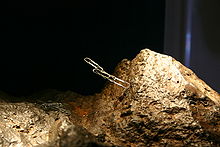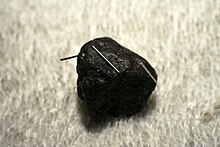Lodestone



A lodestone is a naturally magnetized piece of the mineral magnetite.[1][2] They are naturally occurring magnets, which can attract iron. The property of magnetism was first discovered in antiquity through lodestones.[3] Pieces of lodestone, suspended so they could turn, were the first magnetic compasses,[3][4][5][6] and their importance to early navigation is indicated by the name lodestone, which in Middle English means "course stone" or "leading stone",[7] from the now-obsolete meaning of lode as "journey, way".[8]
Lodestone is one of only a very few minerals that is found naturally magnetized.[1] Magnetite is black or brownish-black, with a metallic luster, a Mohs hardness of 5.5–6.5 and a black streak.
Origin
The process by which lodestone is created has long been an open question in geology. Only a small amount of the magnetite on the Earth is found magnetized as lodestone. Ordinary magnetite is attracted to a magnetic field like iron and steel is, but does not tend to become magnetized itself; it has too low a magnetic coercivity (resistance to demagnetization) to stay magnetized for long.[9] Microscopic examination of lodestones has found them to be made of magnetite (Fe3O4) with inclusions of maghemite (cubic Fe2O3), often with impurity metal ions of titanium, aluminium, and manganese.[9][10][11] This inhomogeneous crystalline structure gives this variety of magnetite sufficient coercivity to remain magnetized and thus be a permanent magnet.[9][10][11]
The other question is how lodestones get magnetized. The Earth's magnetic field at 0.5 gauss is too weak to magnetize a lodestone by itself.[9][10] The leading theory is that lodestones are magnetized by the strong magnetic fields surrounding lightning bolts.[9][10][11] This is supported by the observation that they are mostly found near the surface of the Earth, rather than buried at great depth.[10]
History
One of the earliest known references to lodestone's magnetic properties was made by 6th century BC Greek philosopher Thales of Miletus,[12] whom the ancient Greeks credited with discovering lodestone's attraction to iron and other lodestones.[13] The name magnet may come from lodestones found in Magnesia, Anatolia.[14]
The earliest Chinese literary reference to magnetism occurs in the 4th-century BC Book of the Devil Valley Master (Guiguzi).[15] In the chronicle Lüshi Chunqiu, from the 2nd century BC, it is explicitly stated that "the lodestone makes iron come or it attracts it."[16][17] The earliest mention of a needle's attraction appears in a work composed between 20 and 100 AD, the Lunheng (Balanced Inquiries): "A lodestone attracts a needle."[18] In the 2nd century BC, Chinese geomancers were experimenting with the magnetic properties of lodestone to make a "south-pointing spoon" for divination. When it is placed on a smooth bronze plate, the spoon would invariably rotate to a north-south axis.[19][20][21]
Based on his discovery of an Olmec artifact (a shaped and grooved magnetic bar) in North America, astronomer John Carlson suggests that lodestone may have been used by the Olmec more than a thousand years prior to the Chinese discovery.[22] Carlson speculates that the Olmecs, for astrological or geomantic purposes, used similar artifacts as a directional device, or to orient their temples, the dwellings of the living, or the interments of the dead.[22] Detailed analysis of the Olmec artifact revealed that the "bar" was composed of hematite with titanium lamellae of Fe2–xTixO3 that accounted for the anomalous remanent magnetism of the artifact.[23]
References
- ^ a b Hurlbut, Cornelius Searle; W. Edwin Sharp; Edward Salisbury Dana (1998). Dana's minerals and how to study them. John Wiley and Sons. p. 96. ISBN 0-471-15677-9.
- ^ Bowles, J. F. W.; R. A. Howie; D. J. Vaughan; J. Zussman (2011). Rock-forming Minerals: Non-silicates: oxides, hydroxides and sulphides, Volume 5A, 2nd Ed. UK: Geological Society of London. p. 403. ISBN 186239315X.
- ^ a b Du Trémolet de Lacheisserie, Étienne; Damien Gignoux; Michel Schlenker (2005). Magnetism: Fundamentals. Springer. pp. 3–6. ISBN 0-387-22967-1.
- ^ Dill, J. Gregory (Jan–Feb 2003). "Lodestone and Needle: The rise of the magnetic compass". Ocean Navigator online. Navigator Publishing. Retrieved 2011-10-01.
- ^ Merrill, Ronald T.; Michael W. McElhinny; Phillip L. McFadden (1998). The Magnetic Field of the Earth. Academic Press. p. 3. ISBN 0-12-491246-X.
- ^ Needham, Joseph; Colin A. Ronan (1986). The Shorter Science and Civilization in China. UK: Cambridge Univ. Press. pp. 6, 18. ISBN 0-521-31560-3.
- ^ "Lodestone". Merriam-Webster online dictionary. Merriam-Webster, Inc. 2009. Retrieved 2009-06-12.
- ^ "lodestone". Oxford English Dictionary (Online ed.). Oxford University Press. (Subscription or participating institution membership required.): 'Literally 'way-stone', from the use of the magnet in guiding mariners.'
- ^ a b c d e Livingston, James D. (1996). Driving Force: The Natural Magic of Magnets. Harvard University Press. pp. 14–20. ISBN 0674216458.
- ^ a b c d e Wasilewski, Peter; Günther Kletetschka (1999). "Lodestone: Nature's only permanent magnet - What it is and how it gets charged". Geophysical Research Letters. 26 (15): 2275–78. Bibcode:1999GeoRL..26.2275W. doi:10.1029/1999GL900496.
- ^ a b c Warner, Terence E. (2012). Synthesis, Properties and Mineralogy of Important Inorganic Materials. John Wiley and Sons. pp. 114–115. ISBN 0470976020.
- ^ Brand, Mike; Sharon Neaves; Emily Smith (1995). "Lodestone". Museum of Electricity and Magnetism, Mag Lab U. US National High Magnetic Field Laboratory. Retrieved 2009-06-21.
- ^ Keithley, Joseph F. (1999). The Story of Electrical and Magnetic Measurements: From 500 B.C. to the 1940s. John Wiley and Sons. p. 2. ISBN 0-7803-1193-0.
- ^ The Greek term μαγνῆτις λίθος magnētis lithos (see Platonis Opera, Meyer and Zeller, 1839, p. 989) means "Magnesian stone". It is uncertain whether the adjective μαγνῆτις "of Magnesia" should be taken to refer to the city Magnesia ad Sipylum in Lydia (modern-day Manisa, Turkey) or after the Greek region of Magnesia itself (whence came the colonist who founded the Lydian city); see, for example, "Magnet". Language Hat blog. 28 May 2005. Retrieved 22 March 2013. See also: Paul Hewitt, Conceptual Physics. 10th ed. (2006), p. 458.
- ^ The section "Fanying 2" (反應第二) of The Guiguzi: "其察言也,不失若磁石之取鍼,舌之取燔骨".
- ^ Dillon, Michael (2017). Encyclopedia of Chinese History. Routledge. p. 98. ISBN 978-0415426992.
- ^ Li, Shu-hua (1954). "Origine de la Boussole II. Aimant et Boussole". Isis (in French). 45 (2): 175–196. doi:10.1086/348315. JSTOR 227361.
un passage dans le Liu-che-tch'ouen-ts'ieou [...]: "La pierre d'aimant fait venir le fer ou elle l'attire."
From the section "Jingtong" (精通) of the "Almanac of the Last Autumn Month" (季秋紀): "慈石召鐵,或引之也]" - ^ In the section "A Last Word on Dragons" (亂龍篇 Luanlong) of the Lunheng: "Amber takes up straws, and a load-stone attracts needles" (頓牟掇芥,磁石引針).
- ^ Tom, K. S. (1989). Echoes from Old China: Life, Legends, and Lore of the Middle Kingdom. University of Hawaii Press. p. 108.
- ^ Qian, Gonglin (2000). Chinese Fans: Artistry and Aesthetics. Long River Press. p. 98. ISBN 978-1592650200.
- ^ Curtis Wright, David (2001). The History of China: (The Greenwood Histories of the Modern Nations). Greenwood Publishing Group. p. 42.
- ^ a b Carlson, J. B. (1975). "Lodestone Compass: Chinese or Olmec Primacy?: Multidisciplinary analysis of an Olmec hematite artifact from San Lorenzo, Veracruz, Mexico". Science. 189 (4205): 753–760. Bibcode:1975Sci...189..753C. doi:10.1126/science.189.4205.753. ISSN 0036-8075. PMID 17777565.
- ^ Evans, B. J., Magnetism and Archaeology: Magnetic Oxides in the First American Civilization, p. 1097, Elsevier, Physica B+C 86-88 (1977), S. 1091-1099
